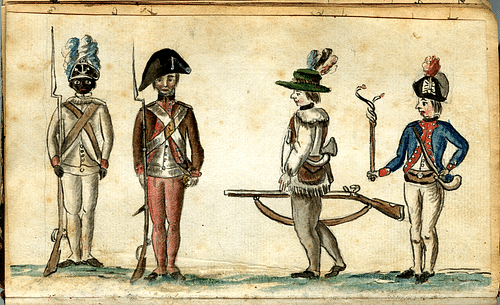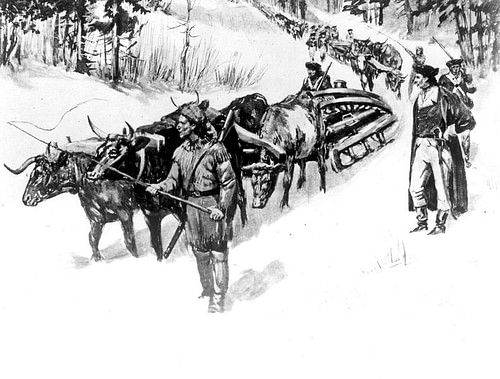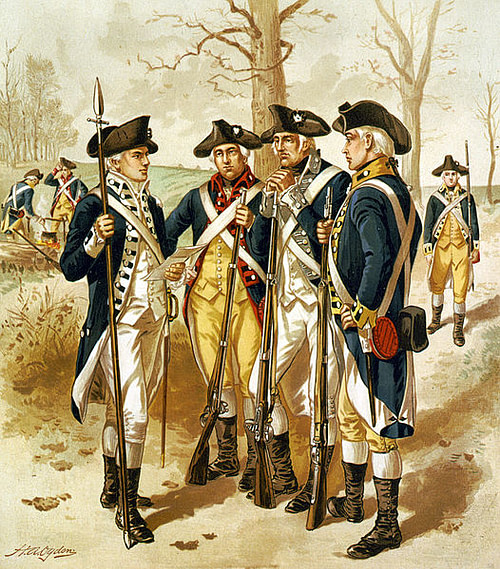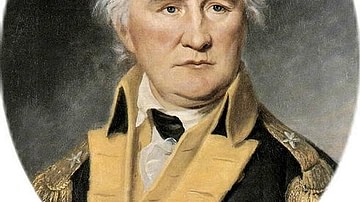The American Revolutionary War (1775-1783) was a long and bitter conflict fought between Great Britain and its thirteen North American colonies over the Americans' liberties and, eventually, for the independence of the United States. The war, which was fought with both conventional linear tactics and guerilla-style warfare, utilized several different kinds of weapons for multiple styles of combat.

Some of the weapons used in the Revolutionary War had long been staples of European-style warfare. Variations of the flintlock musket, for instance, had been used in battle since the early 1600s and would continue to be used on Western battlefields for decades after the American Revolution had ended. Other weapons, like the groove-barreled Long Rifle, were relatively new additions to warfare; the rifle, used in a limited capacity during the Revolution, would see greater use on the later battlefields of the Napoleonic Wars (1803-1815) and American Civil War (1861-1865). Some weapons were useful in close-quarter combat such as the bayonet, tomahawk, and saber, while artillery guns were devastating at both long and short distances. None of the weapons discussed in this article were unique to the American Revolution. However, a quick description of the types of weapons used in that conflict could help give the reader a better understanding of what it may have been like to be on a battlefield during the US War of Independence.
Flintlock Muskets
The flintlock musket was the primary weapon of 18th-century European armies and was therefore used by both sides during the American Revolution. A musket was a muzzle-loading, smoothbore weapon that fired a large lead ball with reasonably decent accuracy. By the 1770s, a typical musket weighed about 10 lbs (4.5 kg), was about 5 ft (152 cm) in length, and had a caliber of about .75 (1.9 cm). A typical lead ball weighed about an ounce (28 g). As the name 'flintlock musket' suggests, such weapons relied on a flintlock mechanism to fire. This involved a piece of flint contained within the musket's cock, or hammer. When the trigger was pulled, the hammer would swing forward, causing the flint to strike a piece of steel called the 'frizzen'. This action created a spark that would fall into a flash pan below, wherein a small charge of black powder was contained. The spark would ignite the powder, which would, in turn, discharge the bullet from the gun barrel. By the time of the revolution, flintlocks had long been the most common kind of firearm; the flintlock had been developed in France in the early 1600s to replace the earlier matchlock and wheellock mechanisms and would remain in use until the mid-19th century.
Although the process of firing a flintlock musket sounds complicated on paper, a well-trained 18th-century soldier could typically fire three or four shots per minute. This is quite impressive, especially after considering what the loading process entails. A soldier would first take a pre-rolled musket cartridge – a paper tube containing gunpowder and a lead musket ball – and tear it open with his teeth. He would then pour a small amount of the powder into the flash pan and pour the rest down the muzzle. Next, the soldier would use a ramrod to pack the musket ball, powder, and paper of the cartridge down into the breech. Only after returning the ramrod to its place and fully cocking back the hammer was the soldier finally ready to take aim and fire.
The musket could be effectively fired from a range of about 80 yards (73 m); while it could sometimes be effective at a slightly greater range, musket balls rarely traveled more than 150 yards (137 m). The musket's accuracy largely depended, of course, on the man who wielded it. To increase the effectiveness of the weapon, 18th-century armies adopted the style of linear warfare; an individual musketeer was less likely to inflict damage than a line of soldiers firing coordinated, concentrated volleys. A typical battle line consisted of two or three ranks of soldiers standing shoulder to shoulder, with each man allowed just enough space to be able to present arms, fire, and reload. When the officer gave the order, the line of soldiers would fire in sync with one another (referred to as a musket volley); sometimes the first rank would kneel to give the second rank a better shot, thereby keeping up a higher rate of fire.
Types of Muskets
The standard musket of the British army was the British Land Pattern Musket, better known as the 'Brown Bess'. This .75 caliber flintlock musket was introduced to the British army in 1722 and remained in use until 1838. Initially, it had a 46-inch-long (116 cm) barrel, although this was shortened to about 39 inches (99 cm) by the late 1770s. The Brown Bess utilized a 'bridle' to support the flash pan, as well as a steel ramrod instead of a wooden one – changes which increased the musket's efficiency and durability. The nickname 'Brown Bess' is likely derived from the brownish color of the musket's barrel, with the name 'Bess' perhaps being a corruption of the term 'buss' as in 'blunderbuss' (Boatner, 118). There is also speculation that the musket was named after Queen Elizabeth I of England (r. 1558-1603), who was often called 'Good Queen Bess', although this has been disputed since the musket was first manufactured over a hundred years after her reign. The Brown Bess, like all military muskets, could be fixed with a 16-inch (40 cm) bayonet, allowing it to be used in close-quarter combat.
The other main type of musket used during the Revolution was the Charleville musket, produced by the French. First developed in 1717, the Charleville remained the standard musket of the French army until the 1840s, although it saw limited use in the Crimean War (1853-1856). A .69 caliber (1.75 cm) musket, the Charleville was smaller than the Brown Bess, an intentional design to make it lighter to carry. During the Revolutionary War, the Americans used both Brown Bess and Charleville muskets. At the outbreak of the war, the Kingdom of France remained ostensibly neutral, although it secretly funneled military supplies to the colonies, including hundreds of Charleville muskets. In 1778, France officially entered the war on the American side, with the French soldiers naturally armed with Charleville muskets as well.
The Americans, of course, relied on a variety of musket types. During the colonial conflicts of the earlier part of the century, every male colonist of military age was expected to join his local militia; this was to protect British colonial settlements from Native American attack as well as from the French, who had long been vying with Britain for control of North America. For this reason, many colonists possessed some variation of the Brown Bess musket when the war broke out; they had either purchased the musket when the colonies had still been part of the British Empire or had acquired it during colonial conflicts such as the recent French and Indian War (1754-1763). Additionally, Americans used Brown Bess muskets stolen from British arsenals or taken from captured soldiers. The Americans were also equipped with the Charleville muskets given to them by the French, as well as muskets manufactured by American gunsmiths. These American muskets, often of an inferior quality to the British and French-made ones, were rarely branded by the gunsmiths, who feared being hanged as traitors if the British won the war. Of course, Continental soldiers and American militias were often undersupplied, leading some Americans to be armed with old and outdated hunting muskets.
Rifles
The rifle had rarely been used as a military weapon prior to the Revolutionary War. Although it was fairly well-known in Europe, where it had been used for hunting since the early 1700s, the rifle remained much less familiar to the Americans; in 1775, John Adams wrote to his wife Abigail to express his fascination with “a peculiar kind of musket, called a rifle” (Boatner, 935). The rifle was, indeed, a kind of flintlock musket; the American Long Rifle, also known as the Kentucky Rifle, was set apart from a normal musket by its grooved barrel, which caused the lead ball to spin as it exited the gun. This momentum gave the rifle a vastly increased range, with most rifles achieving a range of 250 yards (228 m). This increased range and accuracy made the rifle a deadly weapon when placed in the right hands. However, the rifle did have several disadvantages. It took more than twice as long to load as a standard musket and could not be fixed with a bayonet. As such, riflemen were vulnerable in hand-to-hand combat and often could not withstand bayonet or cavalry charges. For these reasons, rifles were used only in a limited capacity during the American Revolutionary War; however, their promising use in that conflict led to a wider use of military rifles in the wars of the 19th century.
At the start of the war, the Second Continental Congress ordered several companies of riflemen to be raised from Pennsylvania, Maryland, and Virginia. These colonies were selected because of their frontiersmen, some of whom had experience with rifles as hunting weapons. The rough and rugged frontier lifestyle meant that many frontiersmen were expert marksmen; rumor had it that an average frontiersman could hit a target as small as an orange from a distance of 200 yards (182 m). These riflemen, commanded by men such as Daniel Morgan, were therefore utilized as sharpshooters, meant to frighten and demoralize the enemy by picking off men and officers during battles and sieges. This tactic was used to great effect during the Battles of Saratoga (19 September and 7 October 1777), when Morgan's riflemen disorientated the British troops by targeting officers; once British General Simon Fraser was mortally wounded by one of Morgan's riflemen, the British soldiers panicked and fled, winning the day for the Americans. Aside from sharpshooting, American riflemen were employed as scouts and skirmishers and were often used to protect the flanks of the main army.
Of course, the British and their allies utilized rifles as well. The German auxiliary soldiers who fought for the British had companies of Jägers (literally 'hunters'), expert marksmen who used military rifles that were typically 45 inches (114 cm) long with 30-inch (76 cm) barrels. The German Jäger troops were particularly effective at striking fear into the hearts of Continental soldiers at the Battle of Long Island (27 August 1776). To a far lesser extent, the British used the Ferguson Rifle, a 7-pound (3.1 kg), 48-inch-long (121 cm), .650 caliber (1.65 cm) weapon. Developed by the Scottish-born Major Patrick Ferguson in 1774, the Ferguson Rifle was loaded from the breech (a chamber located at the end of the gun barrel) rather than from the muzzle. As a result, a soldier could load the Ferguson Rifle while lying down, an impossibility with a muzzle-loaded Kentucky Rifle. Ferguson Rifles were first used by British soldiers at the Battle of Brandywine (11 September 1777); Major Ferguson himself used one to shoot an American officer that he falsely believed to be George Washington. However, only about 100 Ferguson Rifles were issued during the war because the rifle was expensive to manufacture and easily broke down in combat; after Major Ferguson was killed at the Battle of King's Mountain (7 October 1780), the production of his rifle stopped completely.
Close-Quarter Weapons
While battles were primarily fought between lines of soldiers firing musket volleys at one another, actions often devolved into brutal hand-to-hand combat. As previously alluded to, close-quarter fighting usually required the use of the bayonet, a 16-inch (40 cm) steel edge that could be fixed to the muzzle of a musket (though not a rifle during the Revolutionary period). Socket bayonets were designed to allow the musket to still fire while attached, so that soldiers could turn their muskets into melee weapons at a moment's notice. These bayonets often had a triangular blade, which was stronger than earlier single-edged models. By the 18th century, bayonet charges had become a major battlefield tactic, designed to terrify and break the line of enemy soldiers. Wounds caused by bayonets were sometimes difficult to heal with the medical supplies available to army surgeons, often leading to infections and amputations.

Other close-quarter weapons included flintlock pistols, swords, and polearms; these were frequently carried by officers, whose polearms were a symbol of rank as much as a combat weapon. Officers also used their polearms to help direct soldiers in the heat of combat. Cavalrymen, too, used pistols and sabers, although the cavalry saber was longer and heavier than the shorter swords wielded by officers. Knives and tomahawks were also featured on many revolutionary battlefields. These weapons were most often used by Native American fighters as well as by riflemen, who used them in lieu of bayonets.
Artillery
Artillery, in its various forms, had been used in European warfare since the introduction of gunpowder to the region; indeed, the use of artillery on a European battlefield predated the use of small arms. The colonial wars between Britain and France introduced artillery to North American battlefields as well, with the British and colonial troops using it to great effect in the 1745 Siege of Louisbourg. In the leadup to the Revolutionary War, British military officials attempted to prevent artillery pieces from falling into the hands of colonial militias; the search for such artillery pieces led British soldiers to raid colonial weapon stores, with one such raid resulting in the Battles of Lexington and Concord (19 April 1775).
During the subsequent Siege of Boston (19 April 1775 to 17 March 1776), the burgeoning Continental Army had trapped the British army in the city of Boston but did not have enough artillery to end the siege. Colonel Henry Knox was therefore sent to collect the cannons at Fort Ticonderoga, which included 44 field guns, 14 mortars, and a howitzer. In one of the greatest feats of perseverance of the war, Knox's men loaded these guns onto 42 sleds and trekked hundreds of miles through snowy fields, mountain ranges, and across the frozen Hudson River before finally arriving at the Continental Army headquarters at Cambridge, Massachusetts (this expedition became known as Knox's 'Noble Train of Artillery'). Upon arrival, General Washington positioned these cannons on the heights overlooking Boston, forcing the British troops to evacuate the city lest they undergo a devastating bombardment; such was the importance of artillery in the Revolutionary era.

Artillery played an important role in many other engagements, such as the Battle of Princeton (3 January 1777), Battle of Monmouth (28 June 1778), and Siege of Charleston (29 March to 12 May 1780), just to name a few. Field guns were the standard cannons that were used on battlefields. The field guns in Washington's army ranged from 3 to 24 pounders, usually made of bronze; the British made use of the same standard cannons as well as a type of three-pound field gun nicknamed the 'Grasshopper', which stood on legs instead of wheels and got its name because it jumped every time it was fired. Usually, field guns fired roundshot (better known as cannonballs) but were known to use canister shot or grapeshot, especially against an infantry assault. Canister refers to several small bullets and other projectiles enclosed in an encasing; when fired from a cannon, these projectiles would spray outwards in a cone shape, often causing horrendous injuries to the oncoming soldiers.
There were also heavier guns, such as howitzers and mortars, commonly used for sieges. These guns had shorter ranges than field cannons but could fire at a much higher angle. Mortars fired explosive rounds, such as bombs and carcass shots, the latter of which are described by historian Nathaniel Philbrick as “circular metal baskets full of gunpowder, saltpeter, and tallow” (423). It only took two carcass shots fired by the British to engulf the town of Charlestown in flames during the Battle of Bunker Hill (17 June 1775). The range of a field gun could reach up to 2,000 yards (1.8 km); mortars and howitzers usually had an effective range of about 1,300 yards (1.2 km). When the guns were being operated by untrained gunners (as was often the case in the early years of the Continental Army), the effective range could be as short as 400 yards (365 m).

Conclusion
As many as 25,000 Continental soldiers and American militiamen were killed or wounded during the course of the Revolutionary War, alongside around 2,000 French casualties and over 10,000 for the British and Germans (these numbers do not count those who died of sickness or while imprisoned). The lives of these men were ended or changed forever by the weapons described above. From flintlock muskets to breech-loaded rifles, to artillery of all kinds, the American Revolution saw both conventional weapons and new innovations used to devastating effect. The carnage displayed in the Revolution would only worsen in later conflicts, as the weapons described in this article were improved upon, leading to the deadliness of such conflicts as the Napoleonic Wars and the American Civil War.









